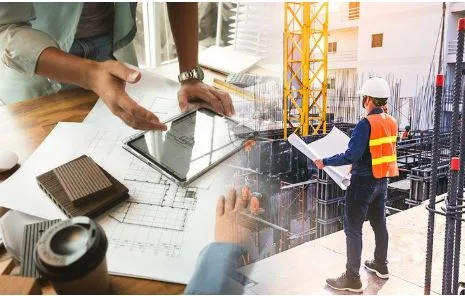How to Reduce Construction Cost?
Have you ever wondered why your construction budget seems to be getting so costly? You’re not alone. The fact is, an increase in the cost of materials, labor shortage, and unpredictable patterns on the market make cost management a real problem. But here is the good news, you can cut the cost of construction and at the same time not lose the quality or safety.
Early planning, proper cost estimates, and employing strategic resource management. The above three steps are sufficient to reduce your project by 15-20 percent and still manage to stay on track of your build.
We will discuss the precise way of how to make that happen, step by step.
Begin With Good Planning and Smart Design
To save money on the construction, it’s not at the job site, but rather at the drawing board, where there are steps to be followed. Ineffectiveness in planning leads to expensive errors, time wastage, and redesign.
The point is the following: a properly planned investment does not only spare money, it avoids financial shocks in the future. Considering the architect or engineer, work closely and finalize all the details before construction. Ensure that your design is practical and has minimization of materials.
Do not have elaborate layout and superfluous building designs unless they are really worth it. Less complicated designs may appear more streamlined, cheaper, and completed within a shorter time.
Accuracy: This is Done by Using Construction Estimation Services
Underestimating the cost of materials and labor is one of the biggest reasons construction projects go over budget. That’s where construction estimation services help you get accurate projections for materials and labor so you can plan efficiently, avoid unexpected expenses, and stay within budget.
Not only do these services assist you in remaining on the right track with regards to finance, but they also avoid unexpected expenses at the implementation. Consider them as your financial plan, keeping your budgeting within budget and increasing the transparency of the project.
You pay attention to know the precise price of each brick, nail and hour of labor so that you are less likely to squander money.
Select the Best Materials: Intelligent Substitution Victories
Materials of construction occupy a gigantic portion of your overall expenses. Yet, the difference can be immense once having to choose the cheaper options that still last. Here’s what this really means:
- Go local. Materials that are locally produced tend to be cheap due to the fact that there are no transportation expenses.
- Compare options. And, as an example, some designs can be made using engineered wood as a substitute of steel beams without losing strength.
- Buy in bulk. Large quantities of ordered materials bring down the unit costs and provide uniformity.
It is not necessarily about being cost-effective, it is being strategic. Intelligent replacements can save the cost in thousands without compromising the performance.
Efficient Labor Management
Inefficiency of labor is a silent killer of costs. An organized workforce will accomplish more within a shorter period of time and time as you well know is money. To minimize the labor-related cost:
- Hire skilled workers. They can be more expensive in the initial phase, yet they are completed in less time, and fewer errors are made.
- Create a realistic schedule. Balance the workloads to avoid overtime and wasted time.
- Motivate your crew. Productivity can be increased with incentives such as bonuses on early completion.
Labor also flows well, your project will advance faster, your staff would be happier, and your wallet would be heavier.
Maximize the Use of Equipment and Technology
The new construction tools and software are not merely fancy and they also save money. At the same time, with Building Information Modeling (BIM), drones, and project management applications, one can pursue resources, minimize rework, and anticipate hazards before they occur.
As an illustration, BIM would be able to detect structural conflicts during an early stage, which would save thousands of dollars in possible rework expenses.
Operation costs can be reduced even on basic matters such as proper maintenance of equipment or renting rather than purchasing heavy machinery.
Oversee and Manage Costs in the Process
Most projects are initiated within the budget but they lose their way because of ineffective tracking. It is important to maintain a fixed eye on costs.
Establish a weekly budget review meeting and evaluate the actual and projected costs. Where you find deviations, deal with them on the spot.
Reduction on construction cost is not a single step, but an ongoing process. One little leak will sink your budget to-morrow.
Go Green: Energy Efficiency Pays Off
Sustainable construction is not only good to the planet, but it is also smart economics. Energy-efficient designs, insulation and use of solar panels might not be cost-effective in the short run, but they reduce the long run operational expenses.
Installation based on environmentally friendly materials can also make your project eligible for tax credits and rebates (depending on the location). You are not only saving at this moment, though, you are also saving in the future.
Recycle and Reuse Materials
Waste is money wasted down the drain. A large number of building materials can be recycled or reused. Indicatively, the remaining concrete, bricks and wood can be used in smaller projects or landscaping and structural backfills.
Recycling will encourage recycling and therefore decrease disposal charges and waste material costs. Also, it is an eco-friendly option, which is a win-win as far as your budget and the planet are concerned.
Bargain and Compare Supplier Prices
This is what most individuals will not consider, it is an art that saves money, negotiation. Never accept the first offer of a supplier. Get estimates of various suppliers and do not only look at the prices but also delivery conditions and terms of payment.
Certainly, costs can be reduced by an early payment discount or a long-term relationship with suppliers in some cases rather than a one-time transaction. Rock-bottom prices are often subdued by consistency and reliability.
Do not Change Design Frequently
One of the quickest ways to run out of budget is in designing after you have started with the construction. Any change, even minor, causes material wastage, labor wastage and time wastage.
To avoid this, work out designs in early stages and follow them. In the event that alterations are a must, cluster them in groups rather than doing them individually.
Conclusion
Saving costs in construction is not involved in being able to cut corners but doing smarter work. Using a strategic plan, correct estimates, effective labor control, and clever material selection, you will be able to fulfill your budget and, at the same time, deliver high-quality results.
Keep in mind, it is clarity rather than compromise that brings cost efficiency. Therefore, budget in advance, keep an eye, and work all the dollars.
FAQs
How can the construction costs be minimized easily?
The easiest and most appropriate way is complete planning and proper budgeting. Early application of digital estimation tools during the design stage will avoid cost surprises at later stages.
To what extent can I save by these tips?
Contractor and homeowners who implement cost saving measures at the early stages may often save up to 10 to 25 per cent of the overall cost of the project, depending on the size of the project.
Are cheaper materials worth it?
Not always. The key is to choose cost-effective materials that maintain performance and durability. Poor-quality materials might save you money now but lead to higher maintenance costs later.
How can technology help in reducing construction costs?
Tools like BIM, project management apps, and cost-tracking software reduce errors, minimize rework, and enhance coordination, all of which translate into real savings.




